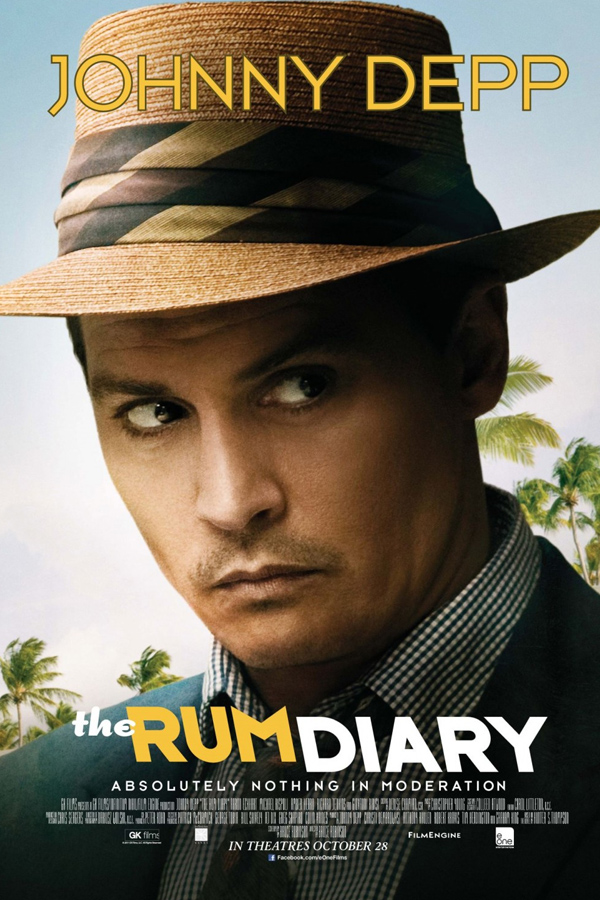 A book could be written solely about Terry Gilliam’s adaptation of Hunter S Thompson’s “Fear and Loathing in Las Vegasâ€, but only about a page could be written for Bruce Robinson’s adaptation of Thompson’s “The Rum Diary.” This version of the journalist’s second novel falls short of doing his talents justice, but gets it right on the rum.
A book could be written solely about Terry Gilliam’s adaptation of Hunter S Thompson’s “Fear and Loathing in Las Vegasâ€, but only about a page could be written for Bruce Robinson’s adaptation of Thompson’s “The Rum Diary.” This version of the journalist’s second novel falls short of doing his talents justice, but gets it right on the rum.
Johnny Depp, 20 years older than appropriate and twice as boring, again stars as the mad writer, this time under Thompson’s self-imposed alias Paul Kemp, sinking himself into the depraved and treacherous terrain of early 1960’s Puerto Rico. There’s booze enough to satisfy a thirsty Kerouac. Mean hangovers and liquor miniatures a-plenty litter the Caribbean horizon, along with the cutthroat politics of journalism and hotel mogul villains, enough to try and deter the young writer, but not enough to actually do so.
Kemp finds some sense of comradery in his fellow degenerate coworkers also disgusted by the daily ongoings of their profession, most importantly in stocky photographer wingman Sala (Michael Rispoli), who unintentionally outperforms the rest of the cast with his light, honest and amusing character.
The pair explore the island’s topography while bustling Sala directs the foreign Kemp with his knowledge of it, as well as run into the money hungry hotel mogul Sanderson (Aaron Eckhart), and his girlfriend, the lustful Chenault (Amber Heard).
Not much of the movie is spent in the offices of the San Juan Star, which employed Kemp, but rather on the life outside, or alongside their work. Dealing with a repulsive Moburg (Giovanni Ribisi), the third wheel on many of Kemp’s and Sala’s adventures, Kemp’s relationship with his love interest Chenault, the terrorizing of natives and police in drunken escapades and Carnival, refuge of the former two when things got too hot in San Juan.
The true villains in “The Rum Diary†would have to be the “bastards†as Kemp referred to them as, or in other words, the hierarchy and bureaucracy of journalism, including his boss, and the audience that demanded boring and glamorous material synonymous with the American dream, which is touched upon ever so slightly.
The movie doesn’t address more underlying themes, a major part of the book; Kemp’s fear of going over the hill and growing up, not turning into older bitter and washed up journalists like Moburg, and Kemp’s reasons for him leaving New York. It skips a lot of sections that detailed Kemp’s relationship with Chenault, one being their rendezvous on a beach where they sleep in wake of Carnival in the book. Yaemon, an accomplice of Kemp’s in the book is completely absent from the movie.
The Rum Diary’s highlights involve Kemp and Sala. Their cockfights, adventuring around the islands, burning the locals and authorities and drinking themselves to the point of sobriety as well as watching the latter’s neighbors TV with binoculars and chugging Sala’s and Moburg’s 470 proof homebrew.
It’s a colorful movie that entertains for the most part, however exaggerating the actualities it’s based on. A temporary tropical getaway cinematographically for the two hours it runs, but hardly more than that.
Music in the movie echoes the sentiments of the time period in which this story is set, from the beginning with a picturesque view of Kemp’s hotel, where he wakes up to the roar of a small plane, tearing apart his curtains with the strength of a thousand hangovers until the end when credits roll.
Good enough for theatrical release. Definitely worth seeing in theaters for diehard fans of the late HST, or any hardcore movie rats for that matter, but fans of HST would not be the most satisfied with this visual interpretation of one of his finest works. Perhaps better suited for direction by P.T. Anderson with Ryan Gosling as Kemp.
Instead, just one more example of a movie that isn’t as good as the book.

Leave a Reply